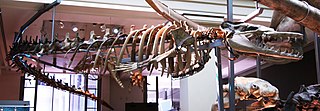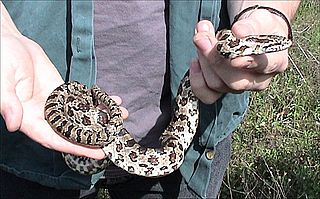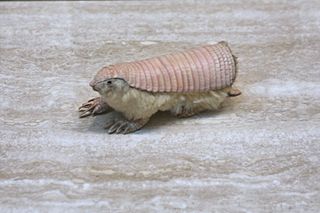 W
WBasilosaurus is a genus of large, predatory, prehistoric archaeocete whale from the late Eocene, approximately 41.3 to 33.9 million years ago (mya). First described in 1834, it was the first archaeocete and prehistoric whale known to science. The first fossils were discovered along the Gulf Coast of the United States, along with a few fossils in the eastern U.S., attributed to the type species B. cetoides. They were originally thought to be of a giant reptile, hence the suffix "-saurus", Ancient Greek for "lizard". The animal was later found to be an early marine mammal, which prompted attempts at renaming the creature, which failed as zoological nomenclature dictates using the original name given. Fossils were later found of the second species, B. isis, in 1904 in North Africa, more specifically the countries of Egypt, Jordan, Tunisia and Morocco. Basilosaurus has a possible record in Seymour Island in Antarctica.
 W
WCyclura is a genus of lizards in the family Iguanidae. Member species of this genus are commonly known as "cycluras" or more commonly as rock iguanas and only occur on islands in the West Indies. Rock iguanas have a high degree of endemism, with in most cases a single species or subspecies restricted to an individual island.
 W
WLampropeltis calligaster is a species of kingsnake known commonly as the prairie kingsnake or yellow-bellied kingsnake.
 W
WThe marsh rice rat is a semiaquatic North American rodent in the family Cricetidae. It usually occurs in wetland habitats, such as swamps and salt marshes. It is found mostly in the eastern and southern United States, from New Jersey and Kansas south to Florida and northeasternmost Tamaulipas, Mexico; its range previously extended further west and north, where it may have been a commensal in corn-cultivating communities. Weighing about 40 to 80 g, the marsh rice rat is a medium-sized rodent that resembles the common black and brown rat. The upperparts are generally gray-brown, but are reddish in many Florida populations. The feet show several specializations for life in the water. The skull is large and flattened, and is short at the front.
 W
WMegalonyx is an extinct genus of ground sloths of the family Megalonychidae, native to North America during Pleistocene epoch. It became extinct during the Quaternary extinction event at the end of the Rancholabrean of the Pleistocene, living from ~2.4 Mya—11,000 years ago. The type species, M. jeffersonii, measured about 3 meters (9.8 ft) and weighed up to 1,000 kilograms (2,200 lb). Megalonyx is descended from Pliometanastes, a genus of ground sloth that had arrived in North America during the Late Miocene, prior to the Great American Biotic Interchange. Megalonyx had the widest distribution of any North American ground sloth, having a range encompassing most of the contiguous United States, extending as far North as Alaska during warm periods.
 W
WThe smooth green snake is a species of North American nonvenomous snake in the family Colubridae. The species is also referred to as the grass snake. It is a slender, "small medium" snake that measures 36–51 cm (14–20 in) as an adult. It gets its common name from its smooth dorsal scales, as opposed to the rough green snake, which has keeled dorsal scales. The smooth green snake is found in marshes, meadows open woods, and along stream edges and is native to regions of Canada, the United States, and northern Mexico. A non-aggressive snake, it seldom bites and usually flees when threatened. It mates in late spring to summer, and females lay their eggs from June to September.
 W
WThe marsh rice rat is a semiaquatic North American rodent in the family Cricetidae. It usually occurs in wetland habitats, such as swamps and salt marshes. It is found mostly in the eastern and southern United States, from New Jersey and Kansas south to Florida and northeasternmost Tamaulipas, Mexico; its range previously extended further west and north, where it may have been a commensal in corn-cultivating communities. Weighing about 40 to 80 g, the marsh rice rat is a medium-sized rodent that resembles the common black and brown rat. The upperparts are generally gray-brown, but are reddish in many Florida populations. The feet show several specializations for life in the water. The skull is large and flattened, and is short at the front.
 W
WThe pink fairy armadillo or pichiciego is the smallest species of armadillo, first described by Richard Harlan in 1825. This solitary, desert-adapted animal is endemic to central Argentina and can be found inhabiting sandy plains, dunes, and scrubby grasslands.
 W
WThe smooth green snake is a species of North American nonvenomous snake in the family Colubridae. The species is also referred to as the grass snake. It is a slender, "small medium" snake that measures 36–51 cm (14–20 in) as an adult. It gets its common name from its smooth dorsal scales, as opposed to the rough green snake, which has keeled dorsal scales. The smooth green snake is found in marshes, meadows open woods, and along stream edges and is native to regions of Canada, the United States, and northern Mexico. A non-aggressive snake, it seldom bites and usually flees when threatened. It mates in late spring to summer, and females lay their eggs from June to September.
 W
WThe Turks and Caicos rock iguana is a species of lizard endemic to the Turks and Caicos islands. This small iguana can reach 30 in (76 cm) and becomes mature at seven years and may live for twenty. A single clutch of up to nine eggs is laid each year, and these take three months to hatch. This iguana is mostly herbivorous, but supplements this by adding some animal matter to its diet.